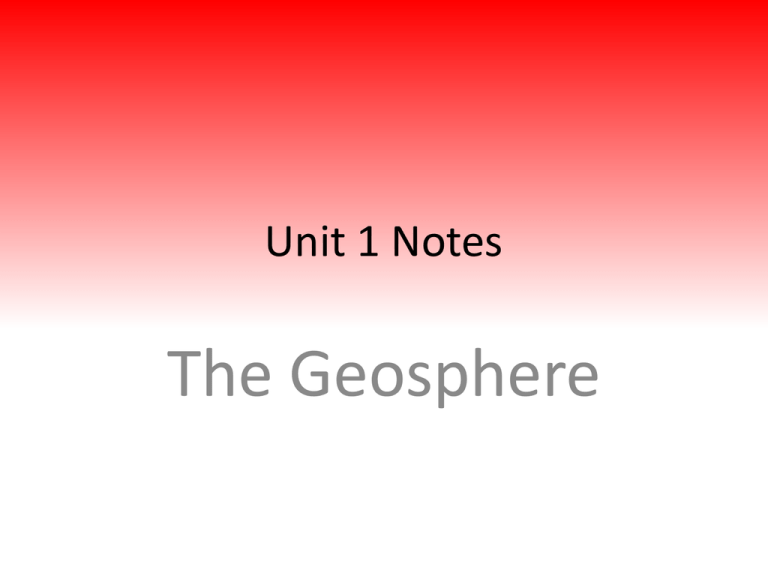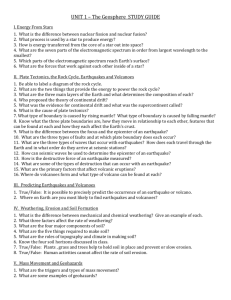The Geosphere Unit 1 Notes
advertisement

Unit 1 Notes The Geosphere Unit Objectives EEn.1.1.3 Explain how the sun produces energy which is transferred to the Earth by radiation. EEn.2.1.1 Explain how the rock cycle, plate tectonics, volcanoes, and earthquakes impact the lithosphere. EEn.2.1.2 Predict the locations of volcanoes, earthquakes, and faults based on information contained in a variety of maps. EEn.2.1.3 Explain how natural actions such as weathering, erosion (wind, water and gravity), and soil formation affect Earth’s surface. EEn.2.1.4 Explain the probability of and preparation for geohazards such as landslides, avalanches, earthquakes and volcanoes in a particular area based on available data EEn.1.1.3 How Stars Produce Energy Combustion vs Burning • Burning is a type of combustion where flames can be seen – Most of the energy from burning is converted into light energy • Combustion is a reaction that takes place without flames so there is more energy in the form of heat produced Nuclear Fission vs Nuclear Fusion • Nuclear Fission – nuclei split • Nuclear Fusion – nuclei combine • Process used in nuclear • The way in which the Sun produces energy power plants Electromagnetic Spectrum Filtering the EM Spectrum • Not every wavelength emitted by stars (including our Sun) reaches Earth’s surface Energy Transfer • Conduction – energy is transferred when particles touch each other • Convection – energy is transferred through fluids (liquids and gasses) • Radiation – energy is transferred by electromagnetic waves Energy Transfer in Stars 1. Nuclear FUSION in the core releasing a photon 2. Photon energy is transferred from one particle to the next through conduction 3. Energy rises to the surface by convection 4. Energy is then radiated out into space by EM waves Solar Forces in Balance • Stars are held together by gravity. • Gravity tries to compress everything to the center. • Thermal and radiation pressure try to expand the star layers outward to infinity. EEn.2.1.1 The Rock Cycle, Plate Tectonics, Volcanoes and Earthquakes The Rock Cycle Forces & Materials in the Rock Cycle • Forces – – – – WEATHERING and EROSION HEAT and PRESSURE COMPACTION and CEMENTATION MELTING and COOLING • Materials – – – – – IGNEOUS ROCK SEDIMENTARY ROCK METAMORPHIC ROCK MAGMA/LAVA SEDIMENTS ROCK CYCLE • Energy is required for rocks to change from one type to the next • Sedimentary = external energy from the Sun to drive weathering and erosion • Igneous & Metamorphic = energy in the form of heat from the Earth’s core Plate Tectonics Earth’s Layers • Crust is thin and rocky – Oceanic = younger rocks – Continental = older rocks • Mantle 82% of Earth’s volume is found here – Lithosphere – a strong layer under the upper mantle – Asthenosphere – a softer layer under the lithosphere • Core – Outer – liquid due to extreme heat – Inner – solid due to intense pressure • Compostion of layers due to density of materials; – heavier elements in the core – lightest elements in the crust Continental Drift • Theory prior to plate tectonics • Proposed by German scientist Alfred Wegener in 1915 • States that the continents had once been joined to form a single supercontinent • Pangaea!!!! Evidence • The continental puzzle • Matching fossils • Similar rock types and structures • Similar ancient climates A New Theory • Wegener’s theory was replaced in the 1950s and 60s by plate tectonics • Takes in to account tectonic activity and mantle convection Causes of Plate Tectonics • Mantle Convection – Transfer of thermal energy by the movement of heated matter in the mantle • Rising mantle – divergent boundary • Falling mantle- convergent boundary – Push and Pull • Ridge push • Slab pull Earth’s Major Plates • The lithosphere is divided into tectonic plates • These plates move and continually change shape and size Types of Boundaries • CONVERGENT – Where 2 tectonic plates are moving together • Creates a subduction zone – Trenches, island arcs and folded mountains • DIVERGENT – Where 2 tectonic plates are moving apart – Volcanism, earthquakes and high heat flow • TRANSFORM – Where 2 tectonic plates are sliding horizontally past one another – Long faults and shallow earthquakes Convergent = Destroy oceanic-continental continental-continental oceanic-oceanic • Form either a subduction zone or a continental collision • Earthquakes and volcanoes are common • Oceanic-Continental = Cascade Mountain Range • Continental-Continental = Himalayas • Oceanic-Oceanic = Mariana Trench, Japan, Aleutian Islands Divergent = Create • Black Hills, SD • East African Rift Valley • Red Sea • Mid-Atlantic Ridge – Seafloor spreading Transform = Conserve San Andreas Fault in California most famous Earthquakes https://www.youtube.com/watch?v=_gE0UnyA2kI • Earthquakes occur because of the forces of plate tectonics – Place where two tectonic plates meet form a boundary; faults are found at these boundaries • Earthquake waves can travel around the world through the different layers of the Earth • There are two parts – the focus and the epicenter Two Parts of an Earthquake • Focus: Point within the Earth where the Earthquake starts. • Epicenter: On the surface above the focus. Types of Faults Reverse Fault/Thrust Fault = Convergent Boundary Normal Fault = Divergent Boundary Strike-Slip Fault = Transform Boundary Two Types of Shocks • Foreshock – Before an earthquake – Can happen years/days before an earthquake • Aftershock – Follows a major earthquake (usually smaller than original quake How do we measure waves? Seismograph Two Types of Waves • Surface Wave – Travel along the Earth’s surface • Body Waves – P wave: push/pull wave through rocks (1st) – S Wave: shake particles at right angles (2nd) P and S Waves Finding the Center of an Earthquake • Use measurements from three seismic stations • Data is used with a distance – time graph to triangulate the earthquake’s origin Measuring Destructive Force • Magnitude (MMS) – amount of energy released at the focus – Measured only at quake site • Intensity (Mercalli Scale) – Amount of shaking – Measured anywhere on Earth The Scales • Richter Scale – Based on the amplitude (height) of the largest wave – Replaced by Moment Magnitude Scale (MMS) • Mercalli Scale – Amount of displacement from the fault Types of Destruction Seismic Vibrations Landslides Tsunamis Fires Volcanoes Factors Affecting Eruptions • Primary Factors – Magma composition • More silica = thicker lava • More iron/magnesium = thinner lava – Magma temperature – Amount of dissolved gases – Viscosity – a substance’s resistance to flow Where Do Volcanoes Form? • Divergent boundaries – Magma chambers are close to the surface due to the plates moving apart • Convergent boundaries – Subducted plate melts and forms magma chambers under the volcano Types of Volcanoes • Shield Volcanoes – Largest type – Form at divergent boundaries • Cinder Cones – Small cones of telphra – Form near shield volcanoes • Composite Cones – Made of alternating layers of lava and telphra – Form at convergent boundaries Other Volcanic Landforms Calderas – a large depression in a volcano • Necks & Pipes – How magma gets through the volcano Lava Plateaus Mt. Saint Helens Eruption May 18, 1980 https://www.youtube.com/watch?v=SJA27Bp1q58 A Supervolcano?!?!? Where could it be? Yellowstone National Park Wyoming, United States https://www.youtube.com/watch?v=DS3RA7NdVKE EEn.2.1.2 Predicting Earthquakes and Volcanoes from Maps Predicting Earthquakes • Short range – very difficult to determine exactly when and where an earthquake will happen, but seismographs give clues • Long range forecasts predict whether an earthquake is likely to occur in a given area within 30 to 100 years. • Because earthquakes and volcanoes occur at plate boundaries, areas along faults are most likely to experience these hazards EEn2.1.3 Weathering, Erosion and Soil Formation Mechanical vs Chemical Weathering Mechanical •Occurs when physical forces break down rocks – temperature & pressure •Three process: – 1.) Frost Wedging – 2.) Unloading – 3.) Biological Activity Chemical • Transformation of a rock from one form to another – Water (hydrolysis), oxygen (oxidation), carbon dioxide (carbonic acid), acid rain • Water: A major factor! Mechanical Weathering Chemical Weathering Rate of Weathering • Three factors are: 1.) Rock Characteristics: the physical way a rock looks 2.) Climate: Temperature and moisture 3.) Differential Weathering: Different parts of rock mass weather at different rates. Just a little soil information • An important product of weathering • Supports growth of plants • Four major components: – – – – 1.) Mineral Matter: about 45% of the matter in soil 2.) Organic Matter: 5% (decayed things) 3.) Water: 25% water 4.) Air: 25% air Different ratios of these components create different types of soils How Soil is Formed • Requires 5 things: – parent material, topography, climate, organisms, time • Creates soil horizons Topography Climate • Cool, dry, sparse vegetation – Predominantly physical weathering • Warm, wet, abundant vegetation – Increased chemical weathering The Soil Profile • Soil varies in texture, composition, structure, and color at different levels. – A Horizon – Topsoil – B Horizon – Subsoil – C Horizon – Bottom true to the parent material – R Horizon Bedrock Erosion • Movement of weathered material from one location to another • Rates of Erosion: – More plants, grass, and trees helps to hold the soil in place. – Human activity that removes these things help to speed up erosion. EEn2.1.4 Mass Movement and Geohazards Mass Movement What it is and its Triggers • The transfer of rock and soil down slope due to gravity and caused by weathering and erosion Water Saturating surfaces creating mudflows Over-steepened Slopes Water cuts under the bank of a river Removal of Vegetation Taking away plants and roots Earthquakes Shake loose soil creating a landslide Types of Mass Movement • Based on the kind of material, how it moves and the speed of the movement. • Rockfall = rocks fall from a steep slope • Slides = land sides down suddenly – High mountain areas • Slumps = downward movement of a block of material in a curved surface • Creep = the slowest form of movement • Flows = mass amounts of movement – 2 types: • Mudflow – Moves quickly • Earthflow – Moves slowly Geohazards Geohazards • • • • • • • Landslides Mudslides Avalanches Falling rock Volcanoes Earthquakes Floods Geohazard Protections • It is impossible to prevent geohazards or to know exactly where and when they will occur • Can use levees, dams, wire netting, breaks and special building codes to help limit damage and save lives • Having a disaster preparedness plan in place is extremely important for EVERYONE! Geohazard Protection Unit 1 Project Family Disaster Preparedness Plan







